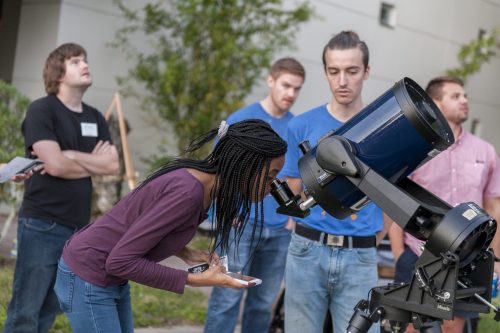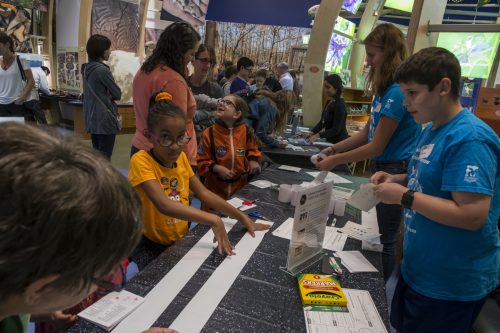GAINESVILLE, Fla. — The Florida Museum of Natural History invites visitors to explore the stars and spend an evening viewing the solar system with astronomy experts Nov. 16 from 6 to 10 p.m. during the annual free “Starry Night” event.

This year’s guest speaker is Paul Torrey, a University of Florida assistant professor of astronomy, who will present “Building the Universe in a Computer” at 7:30 p.m. in the Lucille T. Maloney classroom.
“My research focuses on building numerical models of the universe so that we can better understand what physical processes are responsible for shaping the growth of galaxies and evolution of the cosmos,” Torrey said. “I love the research that I get to do every day and I’m looking forward to the opportunity to share this research with our community.”

The event also features James Albury, co-host of the PBS show “Star Gazers.” Albury will speak about what it’s like to work on the show and play some episode segments at 6:30 p.m. After his talk, Albury will host a meet-and-greet at the Santa Fe astronomy table.
“It’s a wonderful opportunity for visitors to learn about space looking through telescopes that they normally wouldn’t have access to,” said Florida Museum educator Chelsea Collison. “It’s an experience that would inspire awe in anyone.
From 7 to 7:30 p.m., guests can listen to cosmic tunes played on the guitar by Jim Webb. Webb will be playing original music that he says “puts real science in popular music.” His performances include everything from covers of the Beatles to original songs about global warming.

Visitors can also view celestial bodies through high-performance telescopes with the help of Alachua Astronomy Club members.
“What’s not to love about looking up into the night sky and wondering what is out there?” said Florida Museum public programs coordinator Catherine Carey.
Other activities include a space art gallery, two portable planetariums, a cosmic time tunnel and crater creation. Guests can earn prizes by keeping track of completed activities with a “passport to the universe.”
“Starry Night” is made possible by the Florida Museum, University of Florida department of astronomy, Santa Fe College astronomy program, Kika Silva Pla Planetarium, WUFT and Alachua Astronomy Club.
For more information, visit www.floridamuseum.ufl.edu/event/starry-night or call 352-273-2062.
-30-
Writer: Jessica Finkel, 352-273-2032, printern@flmnh.ufl.edu
Sources: Chelsea Collison, 352-273-2062, ccollison@flmnh.ufl.edu; Paul Torrey, (703) 967-7560, paul.torrey@ufl.edu
Media contact: Paul Ramey, 352-273-2054, pramey@flmnh.ufl.edu
Starry Night Activities List
6 to 10 p.m. | Nov. 16, 2018
Florida Museum of Natural History
3215 Hull Road, Powell Hall on the UF campus
The following demonstrations and activities are going on throughout the event unless otherwise noted:
Ask an Astronomer (Denny Gallery)
Want to know more about stars and the universe? Ask a professional astronomer.
Children’s Astro Activities (“Discovery Zone”)
Learn about space with fun activities and interactive games.
Craters & Comets! (patio area)
Create craters and learn how material from space affects the moon.
Cosmic Time Tunnel (galleria)
Experience a journey through cosmic time and space as you travel from Earth to the outer parts of the universe.
Dinner Vendor (front patio)
Enjoy tasty treats and dinner under the stars from Old San Juan Gastronomia.
Discover the Invisible Universe (outside, back lawn)
Listen to radio waves emitted by the Milky Way using the Radio JOVE low-frequency radio telescope. Learn how you can use this equipment to listen to radio waves from Jupiter and the Sun.
Gran Telescopio CANARIAS (Denny Gallery)
Investigate the science and technology used to create the world’s largest telescope, the Gran Telescopio Canarias.
Kika Silva Pla Planetarium (Denny Gallery)
Visit with staff of the Santa Fe College Kika Silva Pla Planetarium, and discover how the team is “bringing the universe to our community.”
Prizes and Giveaways (outside, front entrance)
Return your completed “Passport to the Universe” to receive a prize.
Santa Fe College Astronomy Program (Denny Gallery)
Discover the Santa Fe College Astronomy program and see objects like a portion of the Campo del Cielo, a 70-pound meteorite, as well as space shuttle tiles. Discover the oddities of rocks from space and find out how they differ from ones on Earth!
Stargazing (outside, back lawn)
View celestial bodies through professional-quality telescopes with the help of astronomers from the Alachua Astronomy Club.
Starlab Planetarium Show (Thompson Gallery, presentations every 30 minutes starting at 6 p.m.)
Enjoy the wonders of the constellations and the solar system with this fun and exciting show.
Tim Malles Space Art (inside, front entrance)
See an exhibition of space-inspired art by area artist Tim Malles, who contributed brass plaques to the Gainesville Solar Walk project on Northwest Eighth Avenue.
Tools We Use (Denny Gallery)
Learn about the fascinating and unusual tools astronomers use to study the universe.
-###-